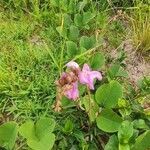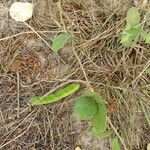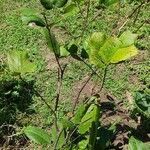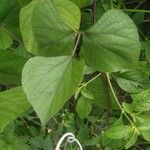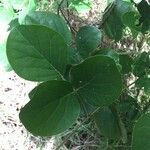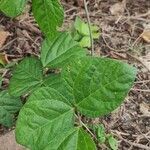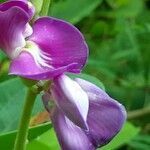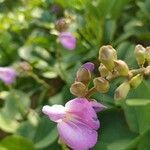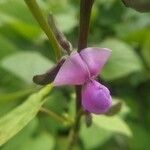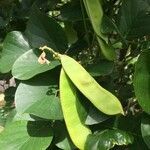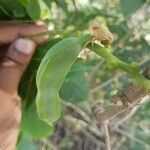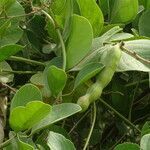Robust perennial prostrate creeper with trailing stems up to 6 m long. Leaflets membranous, orbicular to almost round, emarginate, with conspicuous venation below, 25-150 x 15-110 mm, glabrescent below, sparsely pubescent above; petiole 35-90 mm long; stipules ovate, 3-5 x ± 2 mm. Peduncles very long, (95)150-300 mm long, with 8-14 flowers; flowers 14-30 mm long; bracteoles obtuse, ± 2 x ± 1.5 mm, caducous. Calyx pubescent, upper lip 11-15 mm long, lower lip 8-10 mm long. Corolla pale pink or purple; standard elliptic, 20-30 x 15-20 mm, with a green basal eye surrounded by white rays, emarginate, claw ± 3 mm long; wings obovate, 1822 x 5-6 mm, claw 2-3 mm long; keel more or less equal to wings, 18-20 x 6-7 mm, claw 2-3 mm long. Ovary shortly hairy, 15-16 mm long. Pod linear-oblong, slightly compressed, 110-155 x 20-30 mm; 5-10-seeded. Seeds ellipsoid, 15-20 x 9-14 mm, slightly compressed, brown, hilum less than half the length of the seed.
A perennial climbing or trailing legume. It can be 1.8-10 m long. The stems are silky hairy when young. Leaves have 3 leaflets and the central one is the largest. The leaves are smooth, dark green and slightly leathery. The leaflets are oval or round and often with an indent at the top and 2.5-9.5 cm long by 1.5-9 cm wide. The leaf stalk is 2-7 cm long. The flower cluster can stick upright or hang over. It is 4-18 cm long and the flower stalk is 10-21 cm long. The main rear petal is pink or purple often with a white area near the base. The fruit or pods are oblong and compressed. They are flattened and woody. They can be 11.5-15 cm long by 2.5-3 cm wide. Each section of the pod has a rib. The seeds are brown with streaks. The seeds are 1.5-2 cm long, 0.9-1.4 cm wide and 5-11 mm thick. The seed scar is 7-9 mm long.
Herbs, robust, twining. Stems sparsely puberulent. Leaflets obovate, ovate, elliptic, or suborbicular, 5-8(-14) × 4.5-6.5(-10) cm, pilose on both surfaces, base cuneate to rounded, apex rounded, truncate, emarginate, or mucronate. Racemes axillary, to 30 cm including peduncle. Flowers 1-3 clustered at each node. Calyx 1-1.2 cm, pubescent, upper lip semiorbicular, 3-4 mm. Corolla purple; standard orbicular, ca. 2.5 cm, apex emarginate; wings falcate, auriculate; keel oblong, curved, auriculate. Legumes linear-oblong, 8-12 × 2-2.5 cm, apex rostrate, each valve with extra rib ca. 3 mm from sutural rib. Seeds brown, elliptic, 13-15 × ca. 10 mm; hilum ca. 10 mm. Fl. Jun-Jul.
Perennial climber, or stems trailing, 1.8-10.0 m long; stems silky hairy when young, glabrescent. Leaves pinnately trifoliolate. Leaflets elliptic, oblong-elliptic, somewhat obovate or almost round, glabrous to pubescent on both surfaces, sometimes densely so below. Inflorescences pedunculate, 150-400 mm long. Calyx pubescent; tube 7-9 mm long. Petals standard pink to purple or bluish mauve with a white or yellow patch near base, 30-35 mm long; wings and keel pale magenta. Flowering time Dec.-June. Pod linear-oblong, each valve with a sutural rib and an extra rib below this. Seeds brown, with darker marbling or streaked pale yellow, to almost black.
Leaflets 2.5–12 × 1.5–10 cm, elliptic, oblong-elliptic, somewhat obovate or almost round, mostly rounded to emarginate at the apex but sometimes minutely apiculate, glabrous to pubescent on both surfaces, sometimes densely so beneath; petiole 2–7(10) cm long; rhachis 1.3–4.5 cm long; stipules c. 4 mm long, lanceolate, deciduous.
Pod 11.5–15 × 2.5–2.9 cm, linear-oblong, moderately compressed, each valve with a sutural rib and also an extra rib just below it, appressed pubescent, glabrescent, sometimes wrinkled, c. 6-seeded.
Standard pink to purple or bluish-mauve, with a white or yellow patch near the base, 2.5–3 × 1.5–2.1 cm, round or elliptic, emarginate; wings and keel pale magenta.
Seeds brown, with darker marbling or streaked pale yellow, to almost black, 15–20 × 9–14 × 5–11 mm; hilum 7–8.5(10) mm long.
Inflorescences 15–40 cm long, long-pedunculate; pedicels 3–6 mm long; bracteoles 1.5–2 mm long, obtuse.
Calyx pubescent; tube 7–9 mm long; upper lip 4–5 mm long.
Perennial climber, or stems trailing, 1.8–10 m long.
Stems silky hairy when young, glabrescent.
A nearly glabrous trailing plant
Rose or purple flowers.
